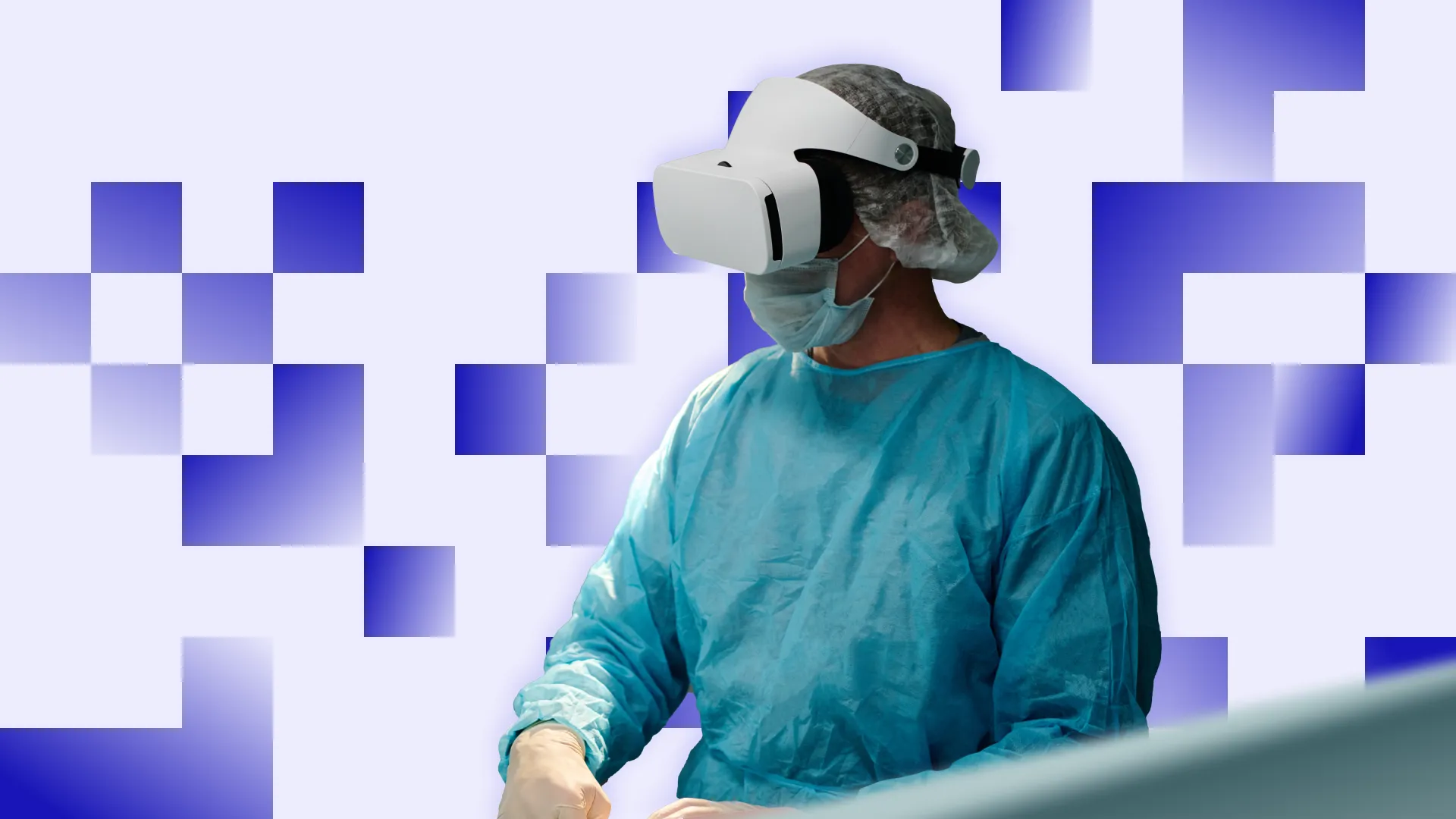The Evolution of Surgical Training
Not too long ago, mastering surgical skills was a painstaking (and often nerve-wracking) journey. It was a high-stakes gamble where every mistake could have irrevocable consequences. But this rite of passage – with its steep learning curve, and the ever-present potential for life-altering errors – was seen as the only road to proficiency.
But surgery is a complex and delicate practice that requires extensive training and experience. And over the years, surgical training has evolved from traditional apprenticeship-style programs to structured educational curriculums.
Finally, there’s a technological revolution that’s rapidly transforming medical education like never before. Virtual reality surgery training immerses learners in a hyper-realistic, risk-free environment where they can practice complex procedures without fear of causing harm. Now, medical professionals have access to advanced and immersive training opportunities that can significantly improve their skills and knowledge.
Traditional Surgical Training Methods
Traditional surgical training methods involve a combination of classroom lectures, textbook readings, and hands-on experience. Residents and trainees attend lectures and workshops to learn about surgical techniques, anatomy, and physiology, before observing and assisting in actual surgeries to gain practical experience.
One of the major benefits of traditional surgical training is the opportunity for trainees to work alongside experienced professionals. Learning from the best in the field gives aspiring surgeons valuable insights into the nuances of some of the most intricate surgical procedures. On top of that, traditional methods provide a more comprehensive understanding of the human body and the various surgical techniques used to treat different conditions.
But, despite all these benefits, these methods have their limitations. After all, surgical training is expensive, time-consuming, and risky. Trainees can make mistakes that could potentially harm patients. And when you consider the unpredictability of surgical training, traditional methods can even hinder the development of certain skills and techniques.
The Emergence of Virtual Reality in Medicine
VR technology has paved the way for a more efficient and immersive approach to surgical training. It allows trainees to experience a number of different surgical procedures – including laparoscopic surgeries, trauma surgeries, and even robotic surgeries – in a controlled and safe environment.
That, in itself, offers several advantages over traditional methods. With VR, trainees can practice specific procedures repeatedly until they feel confident and comfortable performing them in real-life situations, reducing the risk of mistakes and improving patient outcomes. When you add in the fact that virtual reality training is more cost-effective and time-efficient than traditional methods, it’s a win-win.
While virtual reality training is still a relatively new technology in the field of medicine, it’s already showing promising results. In fact, studies have shown that trainees who use virtual reality simulators perform better in real-life surgeries than those who only use traditional methods. So, as technology continues to advance, VR will become an even more integral part of surgical training programs.
Understanding Virtual Reality Surgery Training
It seems simple, but the use of virtual reality in surgical training has revolutionized the way surgeons are trained. In the past, surgical trainees were only able to observe surgeries being performed by experienced surgeons. Now, trainees can actively participate in the surgical procedure and gain hands-on experience in a safe and controlled environment.
VR surgery training systems typically consist of several components:
- A headset, which provides a 360-degree view of the virtual environment;
- Hand controllers, which allow trainees to manipulate surgical instruments and tools;
- A computer or console that runs the simulation software
The headset is designed to be worn for extended periods of time, so it’s lightweight and equipped with high-resolution screens that provide a clear and detailed view of the virtual environment. And the hand controllers mimic the movement and feel of surgical instruments, so trainees get a real sense of what it’s like to practice their surgical skills.
Types of Surgical Procedures in VR Training
Virtual reality surgery training can replicate a range of surgical procedures, including laparoscopic surgeries, trauma surgeries, and robotic surgeries, allowing trainees to practice surgical techniques in a safe and controlled environment, without the risk of harming real patients. It can also be customized to meet the specific needs of individual trainees, allowing everyone to focus on the areas where they need the most practice.
As VR applications continue to emerge, the possibilities for its use in surgical training are expanding. Where does it go from here? VR could be used to train surgeons in complex procedures that are currently difficult to simulate using traditional training methods. Or it could provide ongoing training and education for experienced surgeons, keeping them up-to-date with the latest surgical techniques and technologies.
Advantages of Virtual Reality Surgery Training
Like we mentioned: virtual reality surgery training offers several advantages over traditional training methods. But that’s just the tip of the iceberg when it comes to the benefits of this type of training.
Enhanced Skill Development and Retention
VR allows trainees to practice surgical techniques repeatedly in a controlled and safe environment which helps them develop muscle memory – a must for surgical procedures. The immersive experience also enhances the trainee’s retention of information and improves their confidence in their abilities, thereby reducing anxiety and stress levels in trainees.
For instance, at Stanford University School of Medicine, VR technology is used to transform MRI scans and other medical images into 3D models which are then utilized for practice sessions by surgeons before performing complicated surgeries. This technique, known as Surgical Theater, was used in 2017 to help prepare for a separation surgery of conjoined twins, proving to be a game-changer.
And because VR training can also be tailored to meet the specific needs of each individual trainee, each student can focus on areas where they need the most improvement (rather than wasting time on skills they have already mastered).
Osso VR has partnered with several institutions across the globe for this very purpose. Their surgical training platform provides realistic, hand-based interactions in an immersive training environment that allows for the practice of procedures. For example, surgeons at the Newcastle Surgical Training Centre in the UK have used this technology to practice and perfect orthopedic procedures.
Reduced Training Costs and Time
VR surgical training offers cost-effective education by eliminating expensive equipment needs. It also allows flexible, remote practice at the trainee’s pace, saving time and making training more accessible, especially for those in remote or underserved areas.
According to the Icahn School of Medicine at Mount Sinai, VR training is 83% less expensive and 50% faster than traditional in-person simulation. As a matter of fact, institutions and students leveraging virtual reality for advanced cardiac life support (ACLS) training experienced a significant reduction in cost and time of training.
Improved Patient Safety and Outcomes
The advanced simulation technology in VR allows trainees to practice complex procedures in a risk-free environment, reducing potential errors and complications during live surgery. This leads to improved patient safety and outcomes, as well as reduced healthcare costs associated with surgical errors.
In fact, Yale University School of Medicine conducted a study which found that surgical residents learning gallbladder dissection with VR support showed significant improvements as compared to non-VR-trained residents. Those non-VR-trainess were nine times more likely to transiently fail to make progress and five times more likely to injure the gallbladder.
VR surgical training also helps to identify potential complications before they occur. Trainees can practice responding to unexpected events, such as bleeding or equipment failure, before they happen, so they’re prepared for similar situations during live surgery.
Increased Access to Training Opportunities
VR surgical training increases access to training opportunities for medical professionals, regardless of geographical location or financial resources. It can be used to train medical professionals in developing countries, where access to traditional surgical training may be limited. These are just the first steps to address disparities in surgical education and improve overall healthcare delivery.
Challenges and Limitations of Virtual Reality Surgery Training
Of course, despite its benefits, virtual reality surgery training still faces challenges and limitations. However, with continued advancements in technology and increased adoption, these limitations can be overcome.
Technological Limitations and Realism
Virtual reality technology is constantly evolving, but there are still limitations to its realism. The accuracy of the simulation is essential for the effectiveness of the training. Any errors or inaccuracies in the simulation software could potentially lead to incorrect surgical techniques in real-life situations.
Plus, the level of realism in VR surgery training may not fully prepare trainees for the complexities and nuances of real-life surgery. But as technology continues to improve, VR simulations will become more and more realistic, providing trainees with an increasingly accurate representation of surgical procedures.
High Initial Investment Costs
VR systems can be expensive, making them inaccessible to some medical facilities and trainees. Though the long-term cost is cheaper in comparison, the initial investment costs may be prohibitive, and ongoing maintenance and updates can also be costly.
But the benefits of VR surgery training, including increased safety and reduced costs in the long run, may outweigh the initial investment costs. And as virtual reality technology becomes more widely adopted, the costs should also decrease.
Resistance to Change in Medical Education
As with any change, there is often resistance to the adoption of virtual reality surgery training in the medical education field. Some professionals may be hesitant to embrace new technologies and processes, or feel that it is replacing the traditional apprenticeship model of surgical training.
But VR surgery training can complement traditional training methods, providing trainees with an additional tool to enhance their skills and knowledge. It’s crucial for medical professionals to remain open to new technologies and methods in order to continually improve patient outcomes.
Device Management
Existing device management solutions for companies using VR won’t work in healthcare settings. But managing multiple VR devices in a surgical setting is nearly impossible to do without help. There’s the restricting of web browsers, finding educational content from XR content developers, updating that XR content, and controlling the user experience – all on top of the “business as usual” surgical responsibilities. Obviously, this is even more challenging in large hospitals or in rural hospitals with limited IT resources, so you’ll need a dedicated solution for XR devices.
Conclusion
Virtual reality surgery training offers significant benefits over traditional training methods, providing an immersive and safe environment for the development of surgical skills and knowledge.
Although it’s not without its challenges and limitations, the potential of virtual reality technology in surgical education is promising. As the technology continues to evolve, it is likely that virtual reality surgery training will become more accessible, allowing for better patient outcomes and a more efficient, effective healthcare system.
Plus, innovative companies like ArborXR are addressing the challenges using XR in healthcare by providing dedicated XR MDM solutions. ArborXR can manage all your VR devices, remotely install content, and control what users see and do so you can sleep soundly knowing everything is under control.
Want to explore the use of VR in your surgical training operations? Give us a shout or get started today.

